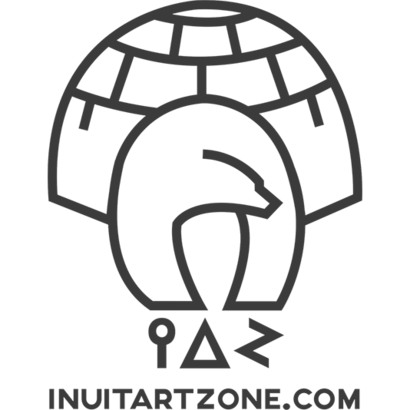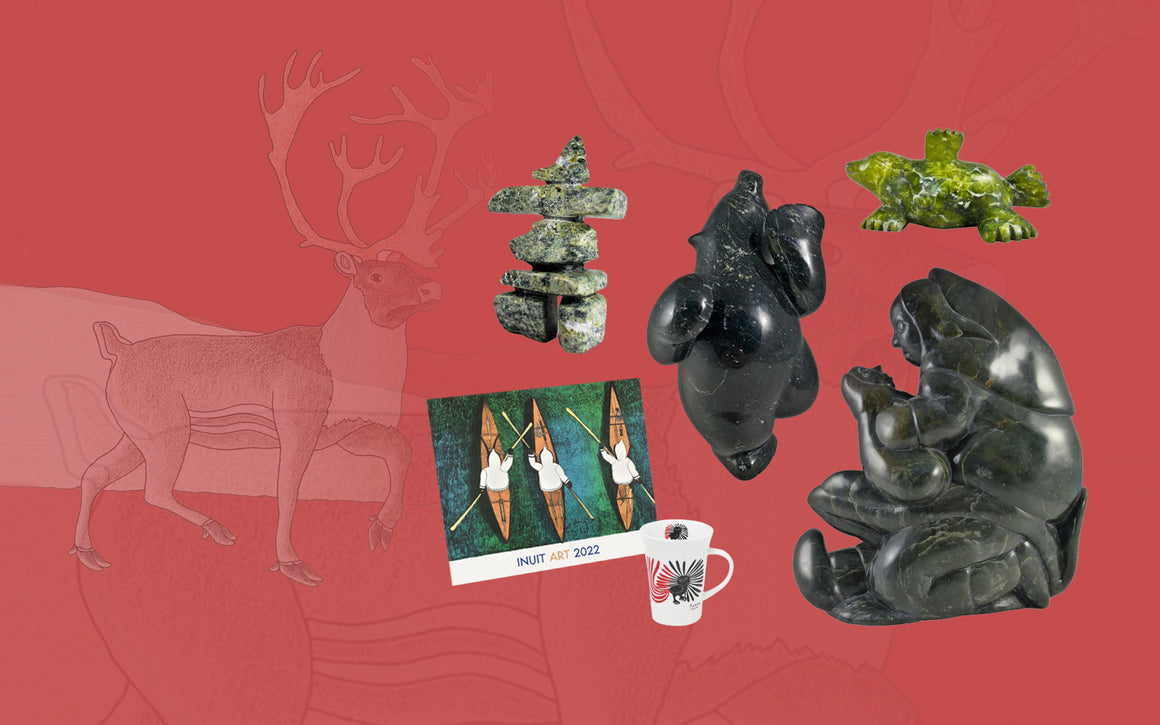Inuit Societies
Co-operatives and artists among the Canadian Arctic
The first Inuit co-operatives
A co-operative is a group gathering people together who work in the same way in order to achieve the same objectives. By 1956, in Kinngait (in Nunavut), the Inuit artists who were looking for mo
re autonomy established the first co-operative in their community with financial supports from the federal government and James Houston’s help, a Canadian artist who worked with Inuit.
The local printmaking studio comes under the control of the co-operative which takes charge of the artists’ pay, material supplies, equipment and the artworks distributions on southern art market. In Panniqtuuq and Kinngait for example printmakers and some drawers are employed by the co-operative at the print shop whereas carvers work freelance even if they often sale their sculptures to the co-operative.
Following the economic success of the artistic program hold at the print shop in Kinngait, new co-operatives and printmaking studios, only managed by Inuit people, were established in other Arctic settlements such as: Puvirnituq (Nunavik) and Iqaluit (Nunavut) in 1962; Ulukhaqtuuq (Holman, Norwest Territories) in 1965; Qamanittuaq (Baker Lake, Nunavut) in 1968; Panniqtuuq (Nunavut) in 1973.
Objectives of Co-operatives
The main objective of each co-operative is to unite the community and to act as a spokesperson for their interests. Therefore the co-operative is more than just an artistic studio, as is evident from their success in activities as diverse like: operating retail store; banking, post offices cable TV and Internet services; management training; staff development and auditing services; marketing Inuit art across Canada and around the world; operating hotels and a travel agency; fishing and hunting camps; bulk storage and distribution of crucial, oil and fuel supplies; constructions projects in Nunavik for housing, school, etc.
The co-operative movement is as important in the Canadian Arctic as it is now the largest non-government employer in the Arctic area with over 270 full-time and 54 seasonal employees in Nunavik and 120 full-time employees in Montreal. The co-operatives are managed exclusively by Inuit staff; thereby ensuring that the knowledge and experience gained from operating their collective enterprises remains an asset of the community.
The Fédération des Coopératives du Nouveau Québec (FCNQ) in Nunavik
The Fédération des Coopératives du Nouveau Québec (FCNQ) is owned by its 14 member’s co-operative in the Inuit communities of Nunavik. The FCNQ was established in 1967 to provide the growing co-operative movement with more effective powers and services to help attain their vision - atautsikut/together - working to develop as a people, leaving none behind.
What it means to be an Inuk, by Abraham Okpik
The text “What it means to be an Inuk” was written in August 1960 by Abraham Okpik who was the first Inuk appointed to the Northwest Territories Council in 1965. Inuit elders and people from the Nunavut government for example are very concerned by the assessment about strong cultural changes that occur among Inuit societies and they work to preserve Inuit language and Inuit knowledge. Abraham Okpik explains:
We the Inuit, where do we come from and how did we get there? This is a big question to us all even in the Qallunaat [non-Inuit]’s way of thinking or learning. We are still a mystery to them, but our ancestors are the ones who we give praise to for all that they have achieved – to live, to feel, to survive for centuries before the white people came. Some of the Qallunaat came with good intentions to teach us a better way of life; some came to destroy our livelihood and culture. But there is one thing we must not forget, and that is how our ancestors brought us this far, in spite of severe cold, and constantly searching for food. Or are we forgetting?
Let us think back fifty years ago and compare our people’s living conditions then with our present living environment. We are gained very little to add to what our forefathers have left us.
So let us realize today we are living in the present times without observing what we are losing, and that is our own Inuit culture, which our grandfathers have passed on to us from generation to generation. Are we keeping our old traditions, or are we going to forget them for good? I am sorry to say we are forgetting them fort now, and if we do not do something to preserve our culture it will just disappear. All will never, never be heard or seen again. […] All will be lost, so let us wake up and restore our old methods and old culture while there is still time, because if we lose it, it will be a tragedy , after all our ancestors have shown us. […]
Today if we can think like our ancestors and put to use what they have achieved for us and adopt the Qallunaat’s way of learning at the same time, and keep our own, we will be further ahead. We should learn as much as we can from this new culture, but we must not forget our own culture which is important to us.
So let us wake up to a new day, with new thoughts, new gifts, and new learning from the new culture. But we must remember our ancestors who had endure the cold, with the help of their knowledge and ingenuity. We could put our learning with this new modern way of living, and only then will we have a bright future, with the white people’s learning and our own culture. […] At the moment we Inuit seem to be off with two different minds. First, the older people know the old way of living; know the language because their forefathers taught them well; and second, the young people are not interested in keeping their own language. They are not being taught to keep their own language. It is important to have own language. At least it will be something we have inherited from our fathers if we keep it.
We should be happy to be who we are, living and working together, keeping our culture strong. After all, we are most comfortable with our own language.
When you learn to work and live the Qallunaat’s way you lose the Inuit way. This can’t be helped. We want progress and comfort and education and security. We can have these things and still keep our language. We need our language to keep us happy together. An Inuk who has lost his language is completely lost. He doesn’t belong anywhere. Keep our language alive and keep the Inuit alive. […] The Inuit language is powerful. It could be used to give many great thoughts to the world. If the Inuit themselves don’t use their language more, and very soon the Inuit too will be a forgotten people. […] It’s no good looking like an Inuk if you can’t speak like one.
There are only very few Inuit, but millions of Qallunaat, just like mosquitoes. It is something very special and wonderful to be an Inuk – they are like the snow geese. If an Inuk forgets his language and his Inuit way, he will be just another mosquito.
Reference:
Okpik, A. (1989). “Qanuq inuuluni tukiqamangaat/What it means to be an Inuk/Ce que signifie être un Inuk”, Inuktitut Magazine, 70: 10-14.
Contemporary Inuit Art in the Canadian Arctic
Artistic diversity
The contemporary Inuit artistic production in the Arctic is extremely rich and varied considering the used practices and techniques as individual and local styles. Each artist works according to his/her own individual and family experience which inspires its creations. The iconographic subjects, the styles and the way of representations which result from it determine the dynamics of the artistic productions.
Domains of creation
Carving constitutes about 80% of Inuit art production and is considered as the major art form in most communities and the one with which Inuit art is most readily associated. The rest of the production corresponds to other artistic domains such as print, drawing, painting; also adding in it the craft productions like pottery, tapestry and sewing.
The notion of “art”
The notion of “art” such as defined by Qallunaat (non-Inuit) does not exist for Inuit because this notion is too much abstracted; so the word "art" does not thus exist in Inuktitut (the Inuit language). Indeed, Inuktitut is an extremely precise language and every element of the word or the sentence has a specific meaning.
Sanannguagaq indicates for example the carving; but its meaning corresponds more exactly at the idea of “making something in miniature, small-scale”. The representation which results from it is a small size replica of the reality.
The Inuit art market
The Inuit artistic creations are intended mainly for Qallunaat according to two kinds of market: the international art market and the tourist market, mainly in North America and Europe.
Today, the contemporary Inuit art is present on an international scale through art galleries, museums and private collections. The artworks contribute to diffuse the image of an Inuit culture anchored in its traditions and resolutely turned to the future.
Shamanism and Christianity
Before the Christianity was adopted, the Inuit way was shamanism. Belief in spirits of the beings - human and animal livings, vegetal, earth - was strong and influenced social behaviour. Nearly all sprits-beings related to the environment and could be influenced by the shaman. Shamanism gradually declined with the increasing dominance of the European religion.
According to their own inclinations, shamans were either good or evil. Greatly feared was a bad shaman who believed only in committing evil acts, including murders. Less feared, though still held in awe, was a good shaman who helped others mainly by healing.
In most camps, shamans would predict weather hunting would be good in a particular year. If the prediction was not promising, the camp would have to follow certain rules, eating only boiled meat for a certain tome, for example. Even if only one member of the camp failed to obey, it was believed that the shaman's dire prediction would happen.
A person had to be chosen by a shaman to be an apprentice and learn how to develop shamanistic powers.
Elders today, although they have heard about shamans from their own parents or grandparents, claim that they can recall little about them. Nevertheless, the stories about shamans healing the sick or restoring the dead to life are still passed on. According to different persons, shamans were thought to still exist in Inuit territories.
Today shamanism is no longer heard from the Inuit communities and practices linked to the shamanistic way are all almost lost. Instead, Inuit have a strong faith in the Bible. Depending on which faith first came to a particular camp or community, people regularly attend Anglican, Roman Catholic, Baptist or other church services.
Shamanism is nevertheless very present into the old as contemporary artistic creation, with representations of human and animal spirits transforming or not, as well as shamans playing drum, for examples. This is a strong and inexhaustible source of inspiration for the Inuit artists.
Inuit Cosmology
In spite of the effects of the christianization, the tradition connected to the shamanism (angakkuuniq in inuktitut) continues, but with adjustments. If Inuit are today Anglican, Catholic or Pentecostal, many people always believe in shamanism: “we believe in these two systems” say the elders in the Canadian Arctic.
Animals and Humans
Formerly, animals constituted an essential source of food, fuel and clothes. It is not thus surprising that the Inuit cosmology insists on the mutual nature of the relations between human and animal. We said that animals gave themselves up to the hunters who pleased them…
Animals and humans own both a spiritual entity (tarniq), but animals serve as food to humans and have no name (atiq): that differentiates them. Only dogs have a particular status, because they possess a name and share the spirit (inua) of their owner.
Silajjuaq, “the universe”
Inuit societies are traditionally animistic, like most of the First Nations’cultures. According to the Inuit thought, the universe (silajjuaq) is occupied by human beings (humans, animals, and vegetables), deceased’s and spirits (tuurnngait) each who live in different but inter-penetrating worlds. Every human being is provided with an anirniq“breathing, breath of life” which, when the subject dies integrates a new animal or human body. The conception of the Inuit world represents a continuum, where every element is a part of a whole.
Rachel Attituq Qitsualik, Inuit writer explains: “The Inuit cosmos is ruled by no one. There are no divine mother and father figures. There are no wind gods and solar creators. There are no eternal punishments in the hereafter, as there are no punishments for children or adults in the here and now.”
Shamanism
The shaman serves as intermediary between these various worlds and maintains the balance. He can be helped by protector auxiliary spirits - tuurnngait - to realize this task; they get to the shaman strength and power. “Yes, obviously there are still shamans. There will be till the end of time.” answered an elder interviewed by young people in the Nunavut Arctic College in Iqaluit.
It is when the shaman travels from a world to the other one, thus entering communication with the deceased’s or spirits’ world as he can change its appearance and be human and animal at the same time… This is what we called the shaman’s transformation. This topic is frequently represented in the contemporary art, in carving with Tukiki Mannomee, Alasua Sharky as in graphic arts with Simon Tookoomee and Noah Maniapik for examples.
Reference:
http://www.tradition-orale.ca/english/cosmology-and-shamanism-b24.html


